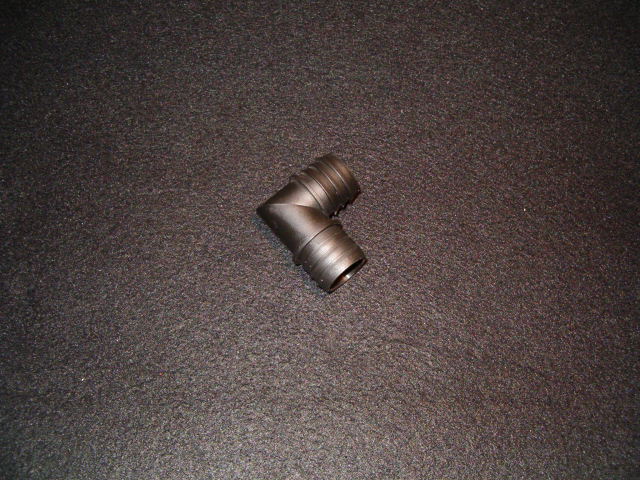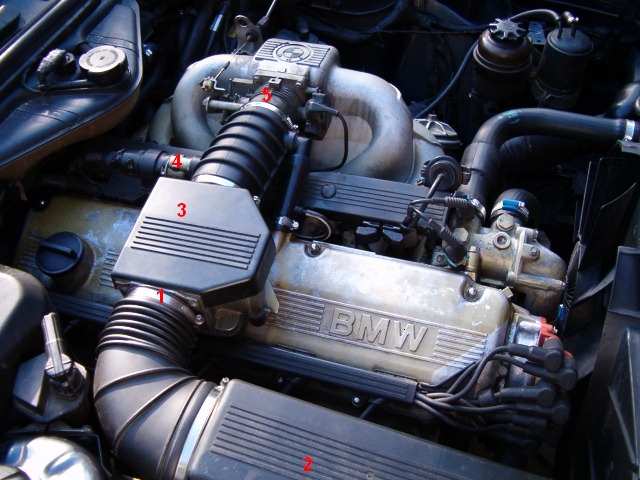Overview
- The Problem
- Tools, Skills And Parts
- Preparations
- Removing Old PCV
- Mounting New PCV
The Problem
The acronym PCV stands for Positive Crankcase Ventilation and is a
system to ventilate and re-burn the small amount of gases that sneaks
past the piston and into the crankcase. Ideally a piston together with
the piston rings should keep absolutely tight against the cylinder wall
and should not let anything pass. However during the compression stroke,
a small amount of gases will escapes past the piston and end up in the
crankcase. These gases must be ventilated out from the crankcase.
There are several reasons why you want to ventilate out these
so-called blow-by gases:
- they consist of approximately 70% of unburned fuel (HC) that can dilute
and contaminate the engine oil causing corrosion to critical parts
- at high engine speeds, blow-by gases increase the crankcase pressure
that can cause oil leakage from sealed engine surfaces
In earlier days, the blow-by gases were simply ventilated directly into
the atmosphere resulting in higher than necessary contribution of
automotive-based air pollution. But later emission regulations prohibit
such solutions.
Tools, Skills And Parts
The job is pretty straightforward and does not include any
special tools.
Difficulty Level

The following tools are required for this particular work (tools marked with
green checkmark are optional).
 | Ratchet wrench (15 cm, small) |
 | Socket extension bar (10 cm) |
 | 10 mm combination wrench (small) | |
 | 10 mm socket | |
 | 6 mm socket | |
 | Screwdriver (flat-blade) |
The following spare parts are required for this particular work (parts marked with
green checkmark are optional). Note that the BMW internal numbers are intended for a
non-EML BMW 535i E34 -89.
Models equipped with EML (Elektronische MotorLeistungsregelung, i.e. electronic
throttle control or drive-by-wire, the PCV layout is different and not included
here.
 | rubber boot | 13 54 1 722 847 |
 | support | 13 54 1 272 473 |
 | ventilation hose | 11 15 1 276 485 |
 | vacuum hose | 51 73 1 259 951 |
 | connection piece | 11 15 1 276 486 |
 | hose clamp 77-84 mm
(2 pcs, rubber boot) | 07 12 9 952 131 |
 | hose clamp 23-29 mm
(1 pcs, ventilation hose) | 07 12 9 952 111 |
 | hose clamp 83-90 mm
(1 pcs, intake air flow meter) | 07 12 9 952 133 |
 | hose clamp 90-110 mm
(1 pcs, output air filter box) | 18 11 1 763 219 |
Preparations
Four parts of the PCV system can be assembled in advance making the installation later on a little bit
easier. The four different parts are shown below together with a picture of them assembled together.




Four parts to be assmebled. From top left to bottom right; vacuum hose,
ventilation hose, support and connection piece.

All four parts assembled.
|
Removing Old PCV
Here follows step-by-step instructions how to remove the old parts and prepare
for the new ones in a very easy way (but maybe not the fastest). Note that it is
not necessary to remove for example the top of the air filter box or the support
for the ICV unit. But by removing these extra things, which is very easily done,
it is a lot easier to install the new parts.

Different parts in the engine compartment numbered out.
Air Filter Box : Start by undo all six metal springs holding the top of the air
filter box (marked with figure 2 in the picture above). Then loosen the hose clamp (marked
with figure 1 in the picture above) at the intake of the air flow meter (marked with figure
3 in the picture above). Use a 6 mm socket (or a flat-blade screwdriver) for the hose clamp.
Now lift up the top of the air filter box and disconnect it from the air flow meter.
ICV: Now the ICV (Idle Control Valve) is to be disconnected. It is marked with
figure 4 in the picture above. The ICV has a support with a mounting point at the valve
cover. Remove the nut on the valve cover. Use a 10 mm socket to remove it. Now simply pull
the ICV unit straight out from the rubber boot.
Air Flow Meter : Next step is to remove the air flow meter. Start by loosen the
hose clamp at the output of the air flow meter. Use a 6 mm socket (or a flat-blade screwdriver)
for the hose clamp. Now remove the three nuts located directly under the air flow meter. Two of
them are hard to get good access to but with a very small 10 mm combination wrench it is possible.
As the last thing, disconnect the electrical contact to the air flow meter (located at the
same side as the oil cap). Now simply lift the air flow meter straight up to remove it.
On the ventilation hose (mounted between the rubber boot and the valve cover) you can see
a small vacuum hose connected near the valve cover. The other end is connected under the
intake manifold. Feel with your hand under the intake manifold and you will find a metal
plug where the vacuum hose is connected to. Just pull it straight out from the intake
manifold. If you are not sure or can not find it, it is possible to see it from beneath.
Loosen the hose clamp on the ventilation hose at the valve cover connection.
Use a 6 mm socket.
Loosen the hose clamp connecting the rubber boot to the throttle housing (marked with
figure 5 in the picture above). Use a 6 mm socket.
Now simply remove the entire rubber boot with ventilation hose and vacuum hose.
Mounting New PCV
Installing the new parts is very straight forward. If you pre-assembled the different
parts as described earlier, here follows a recommended installation procedure.
Press the ICV unit into the rubber boot and then the pre-assembled unit into the
other side. Note! The straight end of the rubber boot is to be connected to the
throttle housing (and the skew end of the rubber boot to the air flow meter).
Mount loosely both ends of the rubber boot to the throttle housing and air flow
meter.
Mount and fastening first the air flow meter then the support for the ICV unit.
Reconnect the electrical contact for the air flow meter.
Tighten the hose clamp connecting the ventilation hose to the valve cover.
Tighten the hose clamp connecting the rubber boot to the throttle housing and
the air flow meter. Don't forget to connect the vacuum hose between the
ventilation hose and the bottom of the intake manifold.
Finally mount the top of the air filter box, lock with all six metal clips
and tighten the hose clamp at the air flow meter intake.
|

